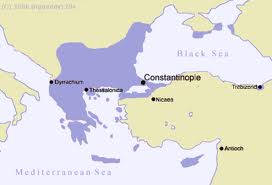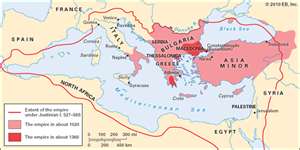|
The term "Byzantine Empire" was coined by Western historians in the 17th century to refer to the Roman Empire after its capital was moved to Constantinople. Constantinople was founded by Roman emperor Constantine, named New Rome, in 330 AD.

The fail of the Western Roman Empire in 476 left Byzantium as the heir to the ancient Roman Empire for almost one thousand years. The Byzantine Empire, heir of the Eastern Roman Empire, withstood the Germanic invasions and developed a brilliant civilization. It finally disappeared in 1453, when the capital, Constantinople (the name of ancient Byzantium), was seized by the Turks.

The Byzantine Empire has one very important geographical feature. It was right on the border between the Christian and Muslim faith, and Jerusalem is in the Byzantine Empire. Thus, making the Byzantine Empire a perfect location for a group of holy wars, which are known as the Crusades.
For months, thousands and thousands of Europeans came through Constantinople to go the Jerusalem, the Holy Land, to fight the Muslims. The experience of visiting the Holy Land in which the Crusades were fought can only be obtained by coming to Byzantium. Nowhere else in the world was there such a significant group of holy wars as the Crusades.

As part of the Byzantine Empire, the city became distinctly Greek as opposed to its former identity in the Roman Empire. Because Constantinople was at the center of two continents, it became a center of commerce, culture, diplomacy, and grew considerably.
The Byzantine Empire, and its capital of Constantinople, held a strategic geographical significance. Constantinople is located right between the Black Sea and the entrance to the Mediterranean Sea. As a result most trade between Asia, Europe and North Africa had to pass through the Byzantine Empire.
Constantinople was the capital of the Byzantine Empire. It had a perfect location. It was on the edge of Europe and Asia. Constantinople was located on a peninsula at the southeastern end of Europe. The city sat along the strait of Bosporous. The Bosporous helps link the Black Sea and the Mediterranean Sea.
Ships travelling between the Mediterranean Sea and the Black Sea had to pass through the Bosporous. This location made Constantinople an important center for trade. The city was guarded on three sides by water. For more protection, leaders built sea walls along the coasts.
|

![]()


